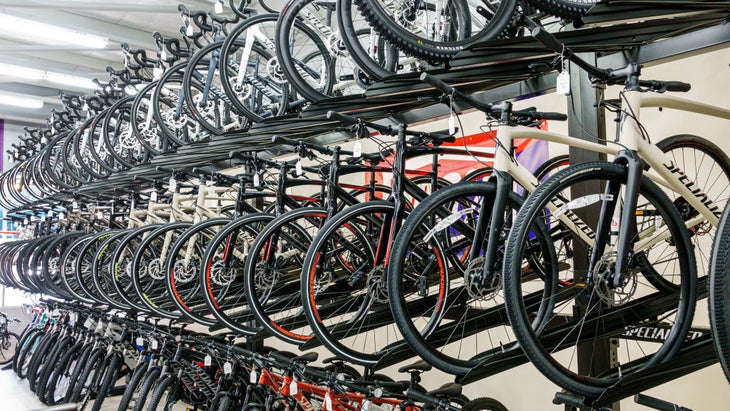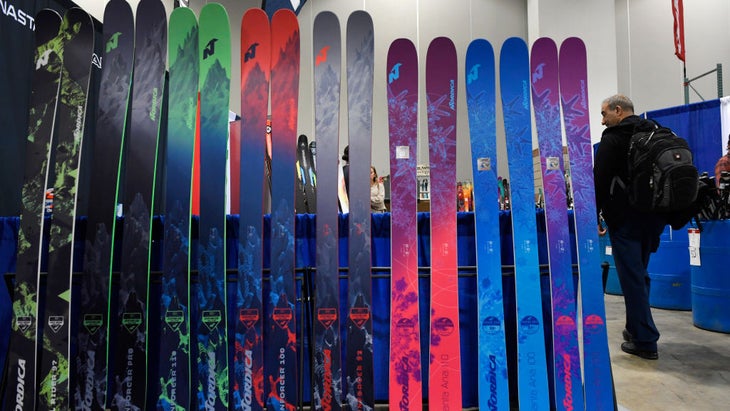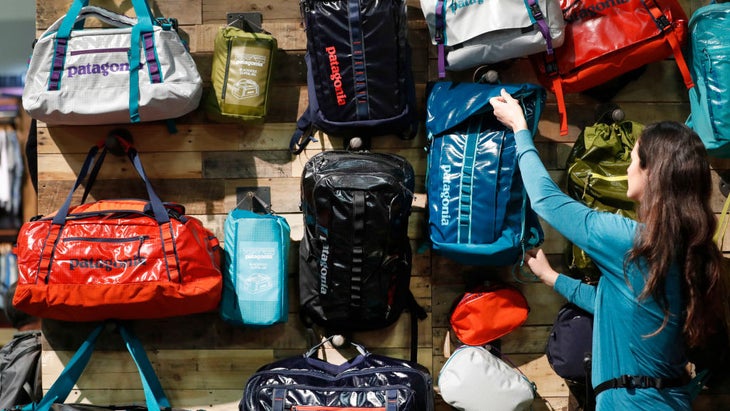John Murtiashaw could not catch a break. In the fall of 2023, Murtiashaw, 38, was working as the sales manager for Appalachian Gear Company (ACG), an apparel brand based in Kings Mountain, North Carolina. Murtiashaw, an eight-year veteran in the outdoor industry, loved the job and his coworkers. There was some serious buzz around the product, and he felt like he was doing good in the world.
Then, in May 2024, AGC went out of business, leaving Murtiashaw, his coworkers, and the brand’s customers shocked and heartbroken. At the end of the summer, after hustling from one job interview to the next, Murtiashaw found work at another North Carolina-based outdoor company, tent-maker Diamond Brand. A few weeks later, right after Murtiashaw received his first paycheck, Hurricane Helene annihilated the region. The factory flooded, the shuttered, and Murtiashaw was out of work again.
“We got three feet of water inside the factory,” he said. “We tried to keep going for a few days, but then we had a meeting.” Management told employees that it was impossible to continue the business with that much damage. They were all let go.
“It was devastating,” Murtiashaw said.
Murtiashaw’s story is familiar to those who work in (or adjacent to) the U.S. outdoor recreation industry. According to the Outdoor Industry Association (OIA), a trade group made up of outdoor businesses, that’s a lot of people: the U.S. outdoor industry—which includes everything from outdoor apparel manufacturers, to guiding companies, to ski resorts—currently employs five million people and accounts for more than two percent of the nation’s gross domestic product (GDP).
But throughougt 2024 and 2025, a litany of outdoor gear brands—from Patagonia to Orvis to REI—have announced revenue shortfalls, downsized their staff, or shuttered altogether. The Outdoor Retailer Trade Show—one of the industry’s biggest events—declared in September that it would drop to just one show per year, combining its summer and winter gear conventions into a single annual event.
The turmoil has generated local and national headlines. It’s also forced many workers, from entry-level employees to business owners, to analyze the micro and macroeconomic forces that are putting financial pressure on businesses. �����ԹϺ��� spoke to a dozen sources to try and understand the roots of the industry’s woes. These sources cited a laundry list of hurdles that the industry faces, from climate change and natural disasters, to supply-chain aftershocks that are still rippling outward from the COVID-19 pandemic. Uncertainty over national politics, and even competition from indoor activities, were also on the list.
“Business has been really tricky,” said Bryce Phillips, founder and CEO of ski-and-bike retailer Evo. “These last two years after the high of COVID have been particularly challenging.”
None of the sources we spoke to could say whether or not the pressure facing the outdoor industry would abet anytime soon.
The Pandemic Boom and Bust
While the pandemic may feel like ancient history, it’s still having very real impacts on the U.S. economy. Supply chains and product inventory in the U.S. still haven’t rebounded to normal levels in multiple sectors. That’s certainly the case for many manufacturers and retailers in outdoor recreation.

Demand for outdoor gear surged during the pandemic, as millions of people sought refuge outdoors. Many manufacturers and retailers ran low on inventory as bikes, skis, and other gear flew off shelves. Brands, which had finished their orders months before, couldn’t restock fast enough.
“Never in our history have we experienced anything like what happened when COVID kicked off,” Phillips said. Stores were selling out of critical equipment.
“On the cycling side for example, chains, chain rings, brake pads—they were impossible to get during the pandemic,” said Sean Smith, show director for the Outdoor Retailer trade show. “The idea for some brands was that if there’s demand, we’re going to fill it. People want our stuff, we’re going to get it to them.”
Many brands ordered huge increases in inventory and hired additional staff and managers to keep up with demand. Surging revenue helped fund this uptick in infrastructure.
For a brief and beautiful moment, the outdoor industry was exploding. But, according to some of the sources we spoke to, some businesses failed to predict that the good times wouldn’t last forever.
According to Phillips, swelling margins masked unchecked spending. “I don’t think any of us managers in the business are loose cannons by any means,” he said. “But it’s human nature: when everything is working well, you’re more apt to spend—and less apt to catch costs that are creeping up.”
The Inventory Problem
As demand boomed, outdoor brands and retailers continued to increase their orders for new product. But when a warm, dry winter struck North America in 2021 and 2022, that slammed the brakes on ski-pass and lift-ticket sales. That was tough on Vail Resorts, which posted losses for several quarters before it ultimately announced layoffs in 2024. Sales of skis and winter apparel were down, too, which affected both Evo and Patagonia, representatives from both companies said.
Then, in mid-2022, the COVID-19 vaccine became readily available. People went back to offices and returned to indoor activities, like concerts and parties. Studies from OIA show that, around this time, the surge in outdoor activity leveled off: after three years of consistent growth, consumers’ average number of annual outdoor outings dropped by almost 7 percent in 2022, and by another 11 percent in 2023.

It’s not that people aren’t going outside—OIA’s 2024 participation survey indicates that the overall number of outdoor recreation participants is still up year over year. But according to that same report, the bulk of new participation is by casual outdoor users—think picnickers, day hikers, and bird watchers. The percentage of more hardcore users—those who make more than 50 outings per year—is dropping, OIA found.
According to Kelly Davis, OIA’s research director, the dip in core participation is tied to a handful of dynamics. Screens, social media, and other activities are increasingly placing demands on consumers’ time and money, she said. What’s more, young people are exercising and spending time outdoors for different reasons than they used to.
“They are out there for their mental health more than for their physical health, and outdoor activities are where they found community during the pandemic,” Davis says.
The bad news is that these hardcore outdoor enthusiasts were the folks most likely to buy a second mountain bike, a new rack of trad gear, or a high-end backcountry ski setup. With the loss of their purchasing enthusiasm, sales of these products have crashed back down to earth, said Matt Powell, a longtime outdoor industry data analyst and founder of Spurwink River Consulting. The reason behind that rise and fall in the data, Powell suggests, might simply be because people in the grips of pandemic lockdown overestimated how much time they’d spend outdoors when restrictions lifted.
“A lot of people bought product above their needs or skill level during the pandemic, and then didn’t have a good experience with it,” Powell said. “People tried new activities and found they didn’t like them or they were too hard.” Outdoor industry analysts incorrectly interpreted the flurry of buying activity as the mass arrival of new lifelong customers. In reality, many were just dabblers.
Yet, most brands continued to order inventory in 2022 and 2023, assuming that sales would continue to grow. And since these companies order a year in advance, many brands have been saddled by excess inventory.
“The business brands were planning for never materialized, but the inventory sure did,” Powell said. Retailers were suddenly bogged down with way too much stuff. So they stopped buying new inventory, and just sat on the piles of old product they already had, hoping it would eventually sell.
“As a result, there hasn’t been a lot of newness out there,” Powell said. “So even the customers who do want to buy haven’t seen anything that feels new and exciting. I don’t care what you say—this business is a fashion business. And when there’s no newness in the market, people get bored.”
Worse, many outdoor retail stores were forced to offer steep discounts to offload all their extra inventory—a task made even more difficult by inflation, which hamstrung consumers’ buying power.
“The steep discounting caused this domino effect,” said Eric Henderson, founder of outdoor industry PR firm Meteorite. When some brands sell gear for pennies, the rest have to drop their prices to keep up. That didn’t help anyone’s bottom lines. The discounting was an especially big hit to smaller brands, which already operate at razor-thin margins, Henderson said.
Inflation Drives Prices Up
If you’ve been buying milk, eggs, gas, or pretty much anything else over the last three years, you’re already familiar with the serious impact inflation has had on the U.S. economy. In August of 2022, it hit a record high of 8.3 percent. That made everything more expensive. Since then, inflation has dropped—it now sits at a very reasonable 2.8 percent—but prices remain high. Then there were the interest rate hikes in 2023, which left some consumers with higher mortgages or car payments. That ate into folks’ discretionary spending even more, and many haven’t yet had time to refinance after the 2024 rate drops.
“People are still spending—consumer spending in 2024 was up year over year—with all this uncertainty and the impact of inflation, people have had to be more discerning,” said Chris Sword, a professor for the University of Colorado’s Outdoor Recreation Economy program. It appears that some consumers have chosen so-called “revenge travel” over a new bike or ice axe this year.

The revenge travel phenomenon got a lot of press in the year or two after the pandemic, but data shows that consumers’ pent-up, post-pandemic wanderlust is still playing out. According to the �����ԹϺ��� Travel Trade Association, a for-profit advocacy group for the travel industry, travel operators are serving 54 percent more clients this year than last. The average trip cost? More than $2,000. The catch is that much of the revenge travel so far has been international. That trend is also projected to continue: Americans took eight percent more trips abroad in 2024 compared to 2023, according to data by travel research company AXA. That means those dollars don’t always flow back into the U.S. economy.
Experts told ���ܳٲ��������that, between 2022 and 2024, consumers were choosing to spend on travel or gear. Many chose to travel. Between that, the dusty inventory, and the warm winter, demand for outdoor gear dried up across most categories. A few items, such as running shoes, have maintained strong sales. But overall, growth stagnated.
“We had an extreme two years of demand that none of us could have ever imagined, followed by a two-year hangover,” said Evo’s Phillips.
“The general vibe from the brands I’ve talked to is that flat [growth year-over-year] is the new good. If you’re flat, you’re going to be fine,” said Henderson “If you’re down? That’s when the panic button gets pushed.”
Brands Lay Employees Off to Cut Costs
In 2024 many brands realized the boom times weren’t coming back, Henderson said. When that happened, they took long and hard looks at their budgets.
“Suddenly, the music stops, and you’re looking at your P&L and scrutinizing all your costs in a way you weren’t before,” Phillips said. That process can reveal some ugly truths. Some brands discovered they had a glut of extraneous personnel that they may have needed in 2020 but just couldn’t keep busy anymore.
At the end of last summer, with the fiscal year coming to a close, companies started to get nervous. One source told �����ԹϺ��� that many brands simply wanted to polish up their bottom lines and pump up their 2025 projections before they closed their books.
Enter the layoffs.
Throughout 2024 and into 2025, the outdoor industry generated a steady cascade of bad news. On January 25, REI laid off 357 staffers, including 200 at its Sumner, Washington, headquarters. It was the REI’s third layoff in 12 months. “Outdoor specialty retail has experienced four quarters of decline—and that trend has been worsening,” REI’s CEO, Eric Artz, .
Then, on September 19, Outdoor Retailer officially nixed its second show. A week later, Vail laid off 14 percent of its corporate staff. On September 30, Patagonia employees were pulled into a call announcing the brand would cut one percent of its workforce. On October 4, Orvis laid off eight percent of its employees. On October 11, footwear brand Vasque shut down. LL Bean announced its second layoff of 2024 in December. In January, apparel company Alpine Parrot, which designed apparel for plus-sized customers, abruptly shuttered. (�����ԹϺ��� Inc., the parent company of OUTSIDE, wasn’t immune from the layoffs, and in February 2025 let go of 23 employees.)

For current (and aspiring) outdoor industry staffers, it felt like gut punch after gut punch. But if the economic headwinds—the excess inventory, the high costs, the supply-chain woes—are years-old, why did these layoffs and closures happen in 2024 and 2025?
“I think there are a lot of [brands] who tried to hold on as long as they possibly could, and then had to make a difficult decision,” said Bruce Old, head of global business operations at Patagonia. “Where we have settled is that we don’t think that the market and some of the risk around the world is going to change significantly.”
In other words, the industry is close to finding its level after the pandemic. While Old hopes trends will continue to stabilize, the reality is that level may be lower than many brands had hired for.
Now, it remains to be seen whether the recent layoffs are enough to course-correct.
“It’s better to make hard decisions deep and early than small and late,” said CU’s Chris Sword. “So, we’ll have to wait and see if these brands cut deep enough to course correct.” If they didn’t, layoffs could continue into 2025.
An Uncertain Future
Adding to the witch’s brew is the shifting political landscape. Political uncertainty historically leads to consumer reticence—a reluctance to buy and an impulse to hoard savings. That goes for brands and consumers alike.
“We’re seeing it in the U.S., and on the international side too,” said Smith. “A lot of people are in this wait-and-see mindset on the economy. Are we going to see increased tariffs on goods coming from China? That’s a legitimate concern. There are a lot of brands waiting to see what will happen next.”
Throughout the early months of 2025, brands have had to endure the threat of the Trump Administration’s evolving agenda on tariffs. In February and March, the U.S. either imposed or threatened tariffs on goods imported from Mexico, Canada, and China.
Matt Tucker, director of client development for Circana’s sports equipment business, has seen that reluctance play out in Circana’s outdoor industry sales data. But a closer look reveals that things aren’t all bad: According to Tucker, the outdoor industry market is down two percent since this time last year. However, the industry has grown 31 percent since 2020. That’s some pretty strong long-term growth.
Henderson believes the post-pandemic pendulum swing has finally come to a stop. It’s stabilizing now, he said, and growth (and hiring) should both resume in 2025. But if you’re looking for an outdoor industry job, don’t hold your breath. Most of the managers interviewed for this story said their biggest lesson from the past few years was acting too fast, hiring or making changes before they had all the data. Going forward, many will be playing it safe.
“We’re patiently assessing what’s happening and proceeding with caution,” said Corey Simpson, Patagonia’s communications manager. “It’s like getting a sketchy avalanche forecast. It could be good, or maybe we’re just drinking coffee at the truck today. We just have to keep assessing as we move forward.”
As for Murtiashaw? He’s feeling cautiously optimistic. For now, he’s still looking for work in the outdoor industry, but he’s not as set on it as he once was.
“I have friends in tech, and they don’t seem that different from me. Honestly, they seem happier,” he said. The tech industry has had its own woes this past year, but Murtiashaw sees some real appeal in selling a product that isn’t physical and therefore isn’t affected by local and international factors beyond employees’ control.
“You’ll likely see me in the outdoor industry again, and loving every minute of it,” he said. “But it’s hard to ignore friends who seem professionally stimulated, stable, with ample time to enjoy outside of work, and wonder if they’ve found a better way.”


